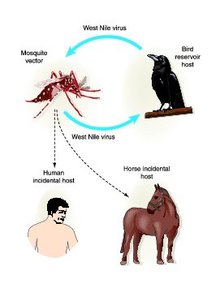The Vermont Agency of Agriculture, Food and Markets was notified on September 14th that a horse located in Whiting, Vermont has tested positive for Eastern equine encephalitis (EEE). The horse began showing signs of illness, including incoordination, on September 6th and was likely infected between August 27th and September 3rd as the result of a bite by an infected mosquito.

Horses and humans - Dead end hosts for EEE
Vermont horse that tested positive for EEE was likely infected late August or early September.
The horse was not vaccinated for EEE. Infection occurred prior to a ‘determination of significant public health risk’, prompting aerial application of adulticide in the region. This case represents the first time that a horse has tested positive for EEE in Vermont.
EEE is a mosquito-borne, viral infection that can cause severe neurologic disease in horses, with mortality rates approaching 100. Although horses are the animals most susceptible to EEE, the virus can also cause disease in other mammals such as llamas and alpacas and in emus. In animals, the onset of clinical signs is generally three to ten days after a bite by an infected mosquito.
Mammals infected with EEE most commonly exhibit neurologic signs including ataxia or incoordination, inability to stand, limb weakness or paralysis, seizures and death, while infected emus often develop hemorrhagic diarrhea.
Mammals infected with EEE are dead-end hosts, meaning that they generally are unable to transmit EEE to other animals or to people. Vermont cases of EEE are required to be reported to the Office of the State Veterinarian.
“Horse owners should consult with their veterinarians to ensure that their horses are appropriately vaccinated for EEE”, reminded Dr. Kristin Haas, Vermont State Veterinarian. Dr. Haas further stated, “A horse’s susceptibility to EEE infection is not linked to travel to shows, fairs or other commingling events. Even horses that spend the majority of their time on isolated properties are susceptible, and those horses should be vaccinated”.
Although vaccination is the most effective tool for preventing EEE in horses, owners may also protect their horses from infection by using an acceptable insect repellent seasonally and mechanical barriers such as fly sheets and face nets. Changing out water troughs regularly and removing other items that hold water will help to reduce mosquito breeding areas.
Because humans are also susceptible to EEE, Vermonters are encouraged to take the following actions to protect themselves from mosquito bites and risk of infection from EEE:
- Limit the amount of time spent outdoors at dawn and dusk.
- Wear long-sleeved shirts and long pants outside when mosquitoes are active.
- Use insect repellents labeled as being effective against mosquitoes.
- Remove standing water around from around your house.
